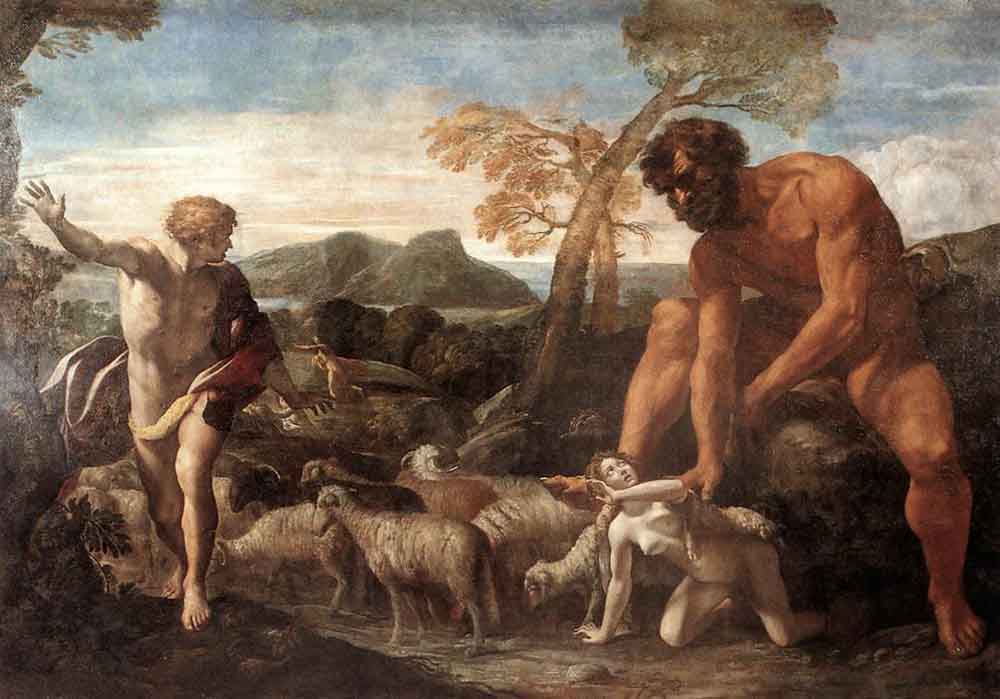The idea of giants having lived in the distant past is a common one in mythology. Norse lore had the Jotun, the Bible mentions the Nephilim, Irish legends had giants like
Finn Mac Cool, and the Hindus have the Daityas. This particular post, however, focuses on the giants of Greek mythology, usually considered to be the children of the primordial earth and sky deities Gaia and Ouranos. Their enormous offspring included the Gigantes (from which our word "giant" originated), the Cyclopes, and the Hecatonchires. Ouranos was so appalled by these hideous offspring that he shoved them back into Gaia's womb, causing her great pain until Kronos freed them and threw them in Tartarus. Kronos was one of the Titans, the offspring of the earth and sky who WEREN'T automatically deemed repulsive. Popular culture has made the Titans giants as well, hence the names of Saturn's moon, the element titanium, and a certain ill-fated ocean liner. I'm not sure whether the Titans were originally conceived as giants, however, or that was a later way to differentiate them from the Olympians.
The Wikipedia entry proposes that later writers might have confused the Titans with their siblings, the Gigantes.

Aside from the Titans, the Cyclopes are probably the best known of Gaia's monstrous offspring. I've seen it speculated that the idea of giants with one eye each was based on elephant skulls, with early discoverers confusing the trunk cavity with an eyehole. While Norse mythology held the dwarves as the makers of the gods' most valuable treasures, this was the role of the Cyclopes in Greek lore. When Zeus freed the one-eyed giants from Tartarus, they provided him with his thunderbolt, and his brothers with their trident and helmet of invisibility. They came to serve Hephaestos as workers in his volcanic forges. Another possible explanation for the single eye (or maybe a complementary explanation) is that blacksmiths of the time often wore eyepatches to protect themselves from flying sparks. Since Greek mythical creatures tend to come in threes, it's not surprising that many references list three Cyclopes: Brontes, Steropes, and Arges. The most famous individual Cyclops, however, is not one of these children of earth and sky, but Polyphemus, the son of Poseidon and the sea nymph Thoosa. It's this Cyclops whom Odysseus blinded, leading the sea god to torment the hero in retaliation. Poseidon is said to have had Cyclops neighbors as well, so Poseidon and Thoosa must have been pretty busy.

The Hecatonchires, or "Hundred-Handed Ones," are known for having...okay, I'm sure you can figure THAT out. Some sources also refer to their having fifty heads. The most famous of these guys is Briareus, but there are two others named Cottus and Gyges. They're apparently strong and nimble with all of their hands, since they're reported as throwing one hundred rocks at a time at the Titans. I wonder if they have dominant hands like humans usually do. It's said that Zeus freed the Hecatonchires so that they could aid the Olympians in battling the Titans, but Dante refers to Briareus as having attacked Zeus and been sent to Hell for it. I've always been a little confused by why Dante put so many opponents of pagan deities in Hell, when he was a Christian who didn't believe that Zeus and his ilk were real gods anyway. Wouldn't Briareus be a hero for attempting to overthrow someone who claimed to be the almighty lord of creation when only God can reasonably claim that position? Then again, Dante wasn't much for nuance, and he apparently thought that anyone who lived before Jesus and wasn't one of the heroes of the Bible ended up in Hell (or at best Limbo; I seem to remember Julius Caesar being there because Dante idolized him for some reason related to Italian nationalism) regardless of how good or bad they were.

Not as much is known about the Gigantes, other than that they were, well, really big. They're also sometimes depicted with snake-like limbs. Legend has it that they were actually born AFTER the Titans, with Gaia conceiving them when fertilized with the blood resulting from Kronos' castrating his father. Kronos imprisoned them in Tartarus as well, and it wasn't until the Olympians had firmly established their rule that Gaia herself encouraged them to rebel against the current order. The war that followed was known as the Gigantomachy, and the Gigantes attempting to reach Olympus by stacking mountains on top of each other. The Olympians were only victorious when Herakles decided to fight on their side.












